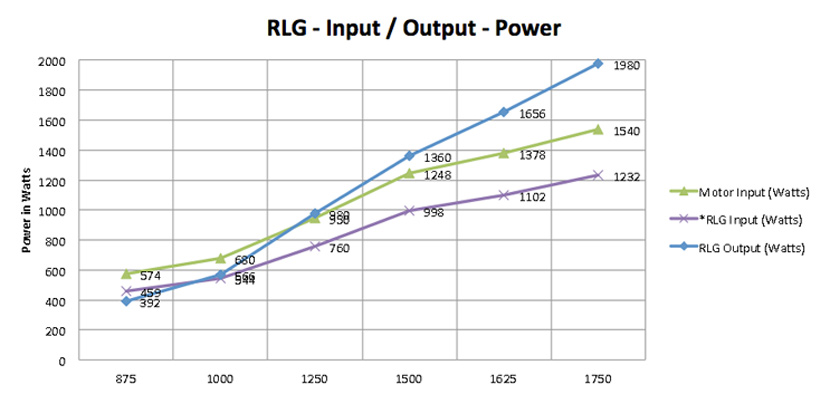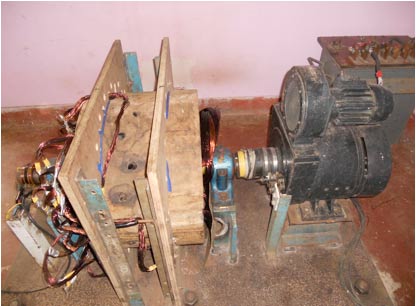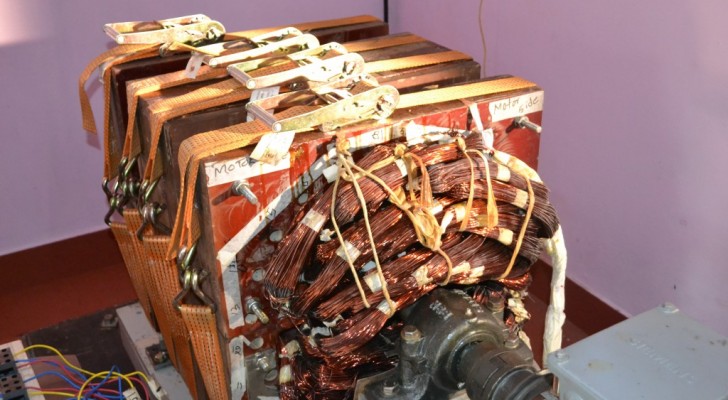India: Tewari's Reactionless Generator Shows Promise
Indian engineer Paramahamsa Tewari, who is not unknown to readers of this site, is experimenting with what he calls a Reaction Less Generator. Measurements taken by Tewari show that the generator is edging towards useful over unity production of electricity.
Ever since the discovery of electromagnetic induction by Faraday and the invention of electrical generators based on these principles, any efficiency higher than unity obtained from these machines has been ruled out due to the Law of Energy Conservation (LCE) and the Lenz's Law. But, through a new Reaction Less Generator (RLG), under development for some time, efficiency much higher than 100% has been achieved.
Tests are now being performed on a small Motor-RLG set which has a DC Motor coupled to an AC RLG. The test results show the graphs of input power to the drive motor and the output from the RLG.

The lowest line on this graph from www.tewari.org (violet) shows the actual input to the RLG from the coupled motor with 0.8 efficiency. The next higher graph (green ) shows the input to RLG without taking motor efficiency into account. The highest graph (blue) shows the output from the RLG. Even at the moderate speed of 1750 r/m, at which the set is run, the ratio: Output from RLG / Input to RLG is 160% (from the lowest and the highest graphs). With extrapolation it can be shown that at 3000 r/m, the efficiency of the M-RLG set will reach 275 %.
Notes on the graph:
1. Power to electromagnets is not taken into account, as these can be replaced by permanent magnets.
2. Entire power produced in the armature circuits has been taken into account. When higher voltages are induced in each circuit, suitable load resistors can be placed in series with the shunt
3. Drive-Motor efficiency is 80%.
While the test results are encouraging, we aren't quite there yet. The research is still preliminary and useful over unity production of electricity, although seemingly within grasp, may still be off some time into the future. I hope to be able to report more news soon.
For now, development is in progress. Speed is being raised, says Tewari, and detailed tests are continuing.

RLG experimental set-up
The explanation to this new RLG phenomenon, says Tewari, comes from the principles of Space Vortex Theory. That theory goes deeper into creation and stability of the electron, the flow of electrons from atom to atom, as they form a current in a conductor, and the creation of the field structure of electrons. All these arise from the absolute vacuum or space (mass less, nonmaterial fluid).
The positive terminal of a DC generator has a shortage of electrons, while the negative terminal has more electrons. This is because the electrons in the atoms of the armature conductors in rotation are interacting with the magnetic fields that strip them of their orbital electrons and pushes [displaces] them to form the negative terminal. When the positive terminal of the generator is connected to the external stationary output circuit, the electrons of the neutral atoms of the circuit, now in contact with the positive terminal, are pulled by the positive generator terminal and this is a continuing process. The negative terminal supplies the electrons that are pulled from atom to atom -- the process starting from the positive generator terminal. Though the atoms of the circuit conductor do work in pulling the electrons from the negative terminal and up to the positive terminal, their structural energy remains intact without any loss. This is because the electrons as well as the atoms are vortices of a mass less, continuous, non viscous, vacuum. The vortices continue to retain their structure despite their continuing interactions.
In a RLG, by a specific configuration of the armature conductor and the magnetic field, a torque that supports the motor torque is created. This way the armature reaction is nullified and Lenz's law is bypassed. There is no creation of energy from any source. There is no applicability of the Law of Conservation of Energy.
We have erred, though unknowingly, in our design of electrical generators and have remained in error for more than two centuries.
- - -
Here is how it started:
In June of 2010, Paramahamsa Tewari announced the discovery of a way to make electric power generation super efficient, in short, to recover more electric energy from a generator than is invested into turning it. His message at the time was:
"Please know this for sure that a Free Power Generator has been discovered! A model of Reaction Less Generator (RLG) has fully nullified the Armature Reaction due to which electrical generators produce a counter torque in opposition to their prime mover's torque. Generators designed with the principles of RLG will require excitation to their electromagnets (if permanent magnets are not used) and windage and frictional power input to the coupled Drive Motor. The armature reaction being zero, a very high overall efficiency --400 to 500 % can be expected. Present discovery pertains to a single phase AC generator and has full possibility to develop into 3 phase generators and also to self running engines through back feeding.
Where does the extra power come from is the question: A generator develops positive (P) and negative (N) polarities across its terminals. Positive polarity has less electrons compared to the negative terminal. When the generator output switch is closed, P pulls electrons from the neutral atoms (A) of the outside circuit thus making it positive, and in turn A , now positive, pulls electrons from its neighboring atoms. This process continues throughout the circuit and the current flows. Both, the atoms and the electrons are vortices of Vacuum--a zero-viscosity, massless, continuous medium. Though the atom's vortices do work in pulling the electrons one after the other , their vortex structure remains the same--there being no loss of their structural energy . So is the case with the electrons----their structure remains the same despite the interactions with the atoms. It is important to note that "co-linear elements of a current flowing in a conductor are Attractive", not repulsive as , perhaps, currently believed. Late Dr. Stefan Marinov was of the same opinion and came to this conclusion through his own Physical Theory, whereas I reached to the above conclusion through the principles of Space Vortex Theory.
Further development of RLG is continuing."
Update from Paramahamsa Tewari - December 31, 2011
"RLG experimental models being tried out now are in 250 V to 415 V conventional voltage and 6 kW range. Overall efficiency now is 160% and higher range. Indian patent has been applied. Future RLG generators, say a 500 kW motor generator unit, can feed 1000 kW to the electrical grid supply. The experiments are proving time and again the correctness of the explananation for RLG effects through SVT principles."
Update 2015:
Here is an article by Toby Grotz describing the progress Tewari has made in these recent years, further developing his generator.
Breaking News: Over-Unity Reactionless Generator Invented In India

Update October 2015:
Economic Times, India
Bengaluru innovator creates super high-efficiency machine that produces power from vacuum
OUT OF THE VOID is a film featuring Paramahamsa Tewari and his invention. It will be premiering at the Vienna International Film Festival in October. And there is also a link...
It's an article in Mother Earth News and it includes links to the Trailer, a Gallery of Photos from the shoot and more.
http://www.motherearthnews.com/renewable-energy/energy-breakthrough-zbcz1601.aspx
Tewari - OUT OF THE VOID - Film Premiere
Paramahamsa Tewari's website is www.tewari.org/
TAPPING NATURE'S LAWS FOR FREE POWER GENERATION - TOWARDS A MORE SUSTAINABLE FUTURE FOR MANKIND
Comments
June 15, 2011 3:14 PM | Posted by: JetMag
If this is Free power Generator...This is what our country needs...having the highest electricity rate in asia..our company Altera Alternative Energy can use this for cheaper power generation..Thanks
June 16, 2011 2:52 PM | Posted by: Prem Das
There have been a lot of movement in the power generation field, a number of seeming breakthroughs, but nothing seem to ever come to fruition.
What gives?
June 17, 2011 9:41 AM | Posted by: G. Srinivasan
comment received by email:
Tewari is a good friend of mine and we presented our respectie models in Hanover Gravity energy conference in 86.
He has put in a tremendous amount of work for which he should be lauded and wish him all the success.
I have conducted research on Vedic science the core core of which is Sankhya.
It has theorems that prove PERPETUAL HARMONIC OSCILLATIONS exists in space
and is the source of all dynamism from gravity to blackhole spectrum.
In order to prove its correctness I have made a magnetic motor generator that produces
incremental overunity power and runs itself. It is being refined and will form the ultimate proof
for the exotic Sankhya theory the origin of which is from Vedic science. My book too will be published
along with it. But you can view my website that contains the first part of my research and you can access it.
Cheers
GS
G.Srinivasan
Kotagiri
http://s2.webstarts.com/Sankhyakarika/index.html
http://sankhyakarika.freelancereporter.org/
http://www.mullerpower.com/Srinivasan/Srinivasan.php
June 17, 2011 9:45 AM | Posted by: Sepp
@ Prem Das
I wish I knew.
Your observation is accurate and certainly deserves an answer. But hard as I look, I have not found it.
July 3, 2011 8:25 AM | Posted by: https://www.google.com/accounts/o8/id?id=AItOawkGJW4TLwjf40gU8EYqLZimFjGQuEgdJPA
@ nSepp, Prem Das and everyone else. The reason for the lack of progress is simple. The connection between what electric inertia is and useful work energy has not been made. The example above reflects this. The simple, underlying principle, is not known, and therefore, is not thought about with regards to an explanation. The inner 3D form of matter, at the inversion layer between pure energy and solid, is forgotten. It's import, neglected. The implication, missed. There is no such thing as an "anomaly", only "not enough thought."